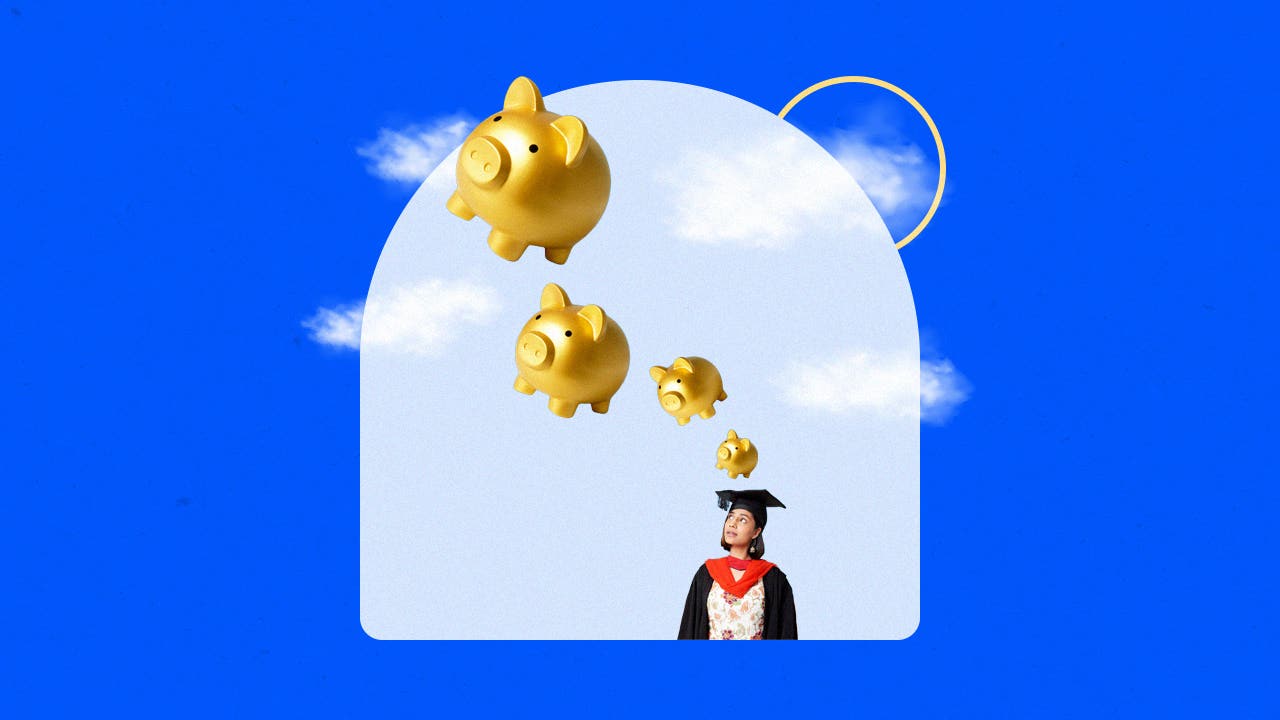Shoulder the burden: Only 30% believe student loan borrowers are responsible for their debt

The Bankrate promise
At Bankrate we strive to help you make smarter financial decisions. While we adhere to strict , this post may contain references to products from our partners. Here's an explanation for .
Key takeaways
- 44% of U.S. adults agree that students don’t get enough education on loans prior to borrowing.
- 30% agree that borrowers shouldn’t be held responsible for paying back their loans in full.
- Still, 69% think that the government has provided borrowers with enough assistance.
In August 2022, the Biden Administration unveiled a massive student loan forgiveness plan that would cancel up to $20,000 worth of federal student debt for eligible borrowers. The proposal — met with both praise and criticism — faced a series of legal battles and was ultimately blocked by the Supreme Court in June 2023.
Now, after more than three years of interest-free moratorium, payments for federal student loans are set to restart in October. But with the cost of higher education more than doubling in the last two decades alone, and degrees becoming essential for many jobs, many feel that borrowers shouldn’t be responsible for paying back their debts in full.
Who’s responsible for repaying student debt?
When you take out a mortgage, an auto loan or a personal loan, you (the borrower) are legally responsible for paying back that debt. If you have a co-signer, that person is equally responsible for repaying your loan. The same principle applies to student loans.
In the case of student loans, the student is responsible for repaying the debt — whether they graduated or not. The only exception to this rule are parent PLUS loans, in which the parent — not the student — is responsible for that debt.
Although the question of who’s responsible for student loan repayment may seem redundant, for many Americans the answer isn’t that black and white. That’s because, unlike other types of debt, for millions, student loans are a necessary tool to cope with the ever-growing costs of higher education. Unfortunately, this tool comes with long-term consequences that borrowers are typically unaware of when they first sign on the dotted line.
44% say students are not educated enough about the pitfalls of student loan debt before borrowing
In a recent Bankrate survey, 44 percent of U.S. adults agreed on the fact that students don’t get the necessary information on the long-term implications of student debt prior to borrowing money for school.
When schools send out financial aid award letters to students, they tend to lump in federal student loans as part of their financial aid package. For many students and their families — especially first-generation students — these loans may seem as just another piece of the puzzle to help them bridge the financial gap. What’s more: financial aid award letters typically show you the maximum loan amounts you’re eligible to receive — not the amount you’ll need — leading to overborrowing in some cases.
Students typically become aware of how much they’ll pay each month once they graduate school, which may end up being an unpleasant surprise. And, if they’re not able to secure a good-paying job from the start, this can hinder their future ability to build wealth. In fact, borrowers, particularly millennials and Gen Z, have delayed important milestones, like saving for retirement, buying a house and even starting a family due to student debt.
30% believe student loan borrowers are responsible for their debt and should pay it back in full
Technically speaking, borrowers, as well as co-signers, are legally responsible for paying back any debts under their name. However, as much as 70 percent of adults surveyed don’t agree that student loans borrowers should be held responsible for paying back their debt in full.
“I think student loan cancellation has mass public support because it is clear that student loans are hampering many Americans and their families,” says Kyra Taylor, staff attorney at the National Consumer Law Center.
“For decades, our student loan system has been plagued with problems that have disproportionately impacted low-income people and people of color,” she adds. “While federal student loans have much better repayment plans and forgiveness options than what is ordinarily available for private student loans, many borrowers never learn about these repayment plans or forgiveness options and even those who know about them may struggle to successfully apply for them.”
These complexities within the nation’s higher education and student loan system may be the reason why so many Americans think that student loan borrowers should get a break.
31% feel the government hasn’t done enough to provide financial assistance to borrowers
But despite the massive support for student loan forgiveness, more than two-thirds of respondents feel the government has done more than enough to provide financial assistance to borrowers.
Besides providing over three years of interest-free moratorium on federal student loans, the government has a series of forgiveness programs and income driven repayment plans in place to help make payments more affordable to borrowers. However, the reality isn’t as simple as that.
“In the past, when many borrowers called their student loan servicer and explained that they could not afford their loans, the student loan servicer did not connect them with an income driven repayment plan or other statutory discharge program that would have provided them with relief, or provided them with incorrect information,” Taylor says.
“Many of these borrowers, unaware of their options and unable to afford their payments, ended up in default,” she continues. “The government has extraordinary collection powers it can use to collect defaulted student loans, including wage garnishment, tax refund offsets, and seizing a portion of some federal benefits. In addition, there are no limits for how long the government can collect on student loan debt, meaning these loans can follow borrowers to the grave.”
So while the government has implemented alternatives to make repayment more manageable, servicers haven’t done enough to facilitate these for borrowers, perpetuating the struggle.
Who owns student loan debt?
Student loans are divided into two main categories: federal and private. Federal loans are government owned, while private loans — as their name suggests — are owned by private entities.
Government-owned loans
Federal student loans, which include Direct Subsidized loans, Direct Unsubsidized loans, Direct Consolidation loans, parent PLUS loans, grad PLUS loans, Perkins loans and some Federal Family Education loans, are owned by the U.S. Department of Education. That said, these loans are administered by different companies, called “loan servicers,” which take care of everything related to billing and account management for the federal government.
There are currently eight federal student loan servicers:
- Great Lakes Educational Loan Services, Inc.
- Edfinancial.
- MOHELA.
- Nelnet.
- OSLA Servicing.
- ECSI.
- Default Resolution Group.
Unlike with privately-owned loans, borrowers can’t choose their student loan servicer. It is assigned to them by the Department of Education and a borrower may have one or more student loan servicers. Additionally, loans can be transferred from one servicer to the next, depending on the contract established by the government.
Privately-owned loans
Private loans are issued by banks, credit unions and online lenders. Unlike student loan servicers, private companies own these loans and can also sell them to other companies at any given time.
Some of the most popular private lenders include:
- Discover.
- SoFi.
- Sallie Mae.
- College Ave.
- Earnest.
These loans can have either fixed or variable rates, so if your loan is transferred to another lender and you have a variable rate, you could see your rates increase or decrease. Unlike federal student loans, which are assigned to a randomly selected servicer, with a private loan, you have to choose the company you wish to apply to. This gives you more control over the repayment terms and interest rates you’ll have on your loans.
How student loans work
Student loans are a type of installment loan, meaning that they’re repaid over a set period of time. These loans can be used to pay for tuition and required fees, as well as other college-related expenses, like room and board, books and other course materials.
There are two main types of student loans: federal and private. Federal student loans are issued by the Department of Education and have fixed interest rates. To apply for federal student student loans, you just need to fill out the FAFSA. Anyone in good academic standing and enrolled at least half time can qualify. However, the amount you get varies based on your dependency status and number of credits completed.
Private student loans, on the other hand, are issued based on credit. That means you’ll need good credit and a stable source of income to qualify for these or a co-signer that meets these requirements. Private student loans can be obtained from banks, credit unions and online lenders. With private student loans, borrowers are typically allowed to borrow up to their full cost of attendance, as certified by the school. These loans can have fixed or variable interest rates.
Both federal and private loans don’t require you to make payments until six months after you graduate or drop below half-time enrollment. However, although most people use a combination of both to pay for school, it’s best to stick with just federal loans if possible. This is because federal loans offer a series of protections, like administrative forbearances, forgiveness plans and income driven repayment plans, that aren’t available through private lenders.
FAQs
-
On June 30, 2023, the Supreme Court rejected Biden’s one-time student loan forgiveness plan. Under this plan, borrowers earning up to $125,000 a year (or up to $250,000 if married) would have gotten up to $20,000 worth of federal student loans automatically discharged from their balance.Although the administration is crafting a new plan to make payments more affordable, for now, mass student loan forgiveness isn’t a possibility for borrowers.
-
Payments for federal student loans are set to resume in October. The Department of Education will be in touch with borrowers to let them know the exact date when their payments will be due. However, interest accrual will begin on September 1, 2023.
-
While mass forgiveness is off the table, you may still be eligible for forgiveness if you meet the eligibility criteria for other forgiveness programs offered by the Department of Education. These include Public Service Loan Forgiveness (PSLF), the Nurse Corps Repayment Program and the Teacher Loan Forgiveness. However, it should be noted that these programs are strictly for federal student loans — private student loans aren’t included in these forms of relief.
-
To apply for any of the Department of Education’s forgiveness programs, simply visit StudentAid.gov and log in to your account. From there, you’ll be able to select the program you wish to apply for, and you’ll be prompted to fill out a form. You may also be required to submit additional documentation, depending on the program you apply to, in addition to contacting your loan servicer.
-
When a student loan is in forbearance, interest typically continues to accrue while payments are temporarily paused. Meanwhile, when in deferment there’s always a chance that the pause is interest free, depending on the type of loan you have.Regardless, you’ll have to contact your student loan servicer and fill out a form that demonstrates financial hardship to qualify. If you have more than one servicer, you’ll have to do this individually for each loan. Private lenders may also offer these options, however, these vary from one company to the next, so you’ll have to contact your lender to see if this is an option.
-
If you miss a student loan payment, your lender or servicer may assess a late payment fee, depending on how many days late the payment is. However, if you’ve missed a payment for 90 or more, then the loan will be considered in default, which can have serious credit, financial and legal consequences.
Related Articles




Is student loan debt a national crisis? 48% of borrowers say so